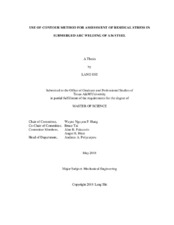| dc.contributor.advisor | Hung, Wayne Nguyen | |
| dc.contributor.advisor | Tai, Bruce | |
| dc.creator | Shi, Lang | |
| dc.date.accessioned | 2019-01-17T17:31:50Z | |
| dc.date.available | 2020-05-01T06:24:18Z | |
| dc.date.created | 2018-05 | |
| dc.date.issued | 2018-04-27 | |
| dc.date.submitted | May 2018 | |
| dc.identifier.uri | https://hdl.handle.net/1969.1/173422 | |
| dc.description.abstract | This research presents a method to measure and calculate residual stress in A36 steel after submerged arc welding. Finite element is used to simulate the welding process and is compared with experimental data. After depositing beads on rectangular steel blocks, wire electrical discharge machining was used to section the blocks and welding bead in three orthogonal directions. The deformed surfaces due to releasing residual stress were measured using 3D optical technique. The surface topographies were used as boundary conditions in finite element analysis to calculate resulting residual stresses. The residual stress profiles from experiments and simulation are about 90% in agreement | en |
| dc.format.mimetype | application/pdf | |
| dc.language.iso | en | |
| dc.subject | Residual Stress | en |
| dc.subject | Submerged Arc Welding | en |
| dc.subject | Finite Element Method | en |
| dc.subject | Contour Method | en |
| dc.title | Use of Contour Method for Assessment of Residual Stress in Submerged Arc Welding of A36 Steel | en |
| dc.type | Thesis | en |
| thesis.degree.department | Mechanical Engineering | en |
| thesis.degree.discipline | Mechanical Engineering | en |
| thesis.degree.grantor | Texas A & M University | en |
| thesis.degree.name | Master of Science | en |
| thesis.degree.level | Masters | en |
| dc.contributor.committeeMember | Palazzolo, Alan B | |
| dc.contributor.committeeMember | Price, Angie H | |
| dc.type.material | text | en |
| dc.date.updated | 2019-01-17T17:31:51Z | |
| local.embargo.terms | 2020-05-01 | |
| local.etdauthor.orcid | 0000-0003-0515-8491 | |


